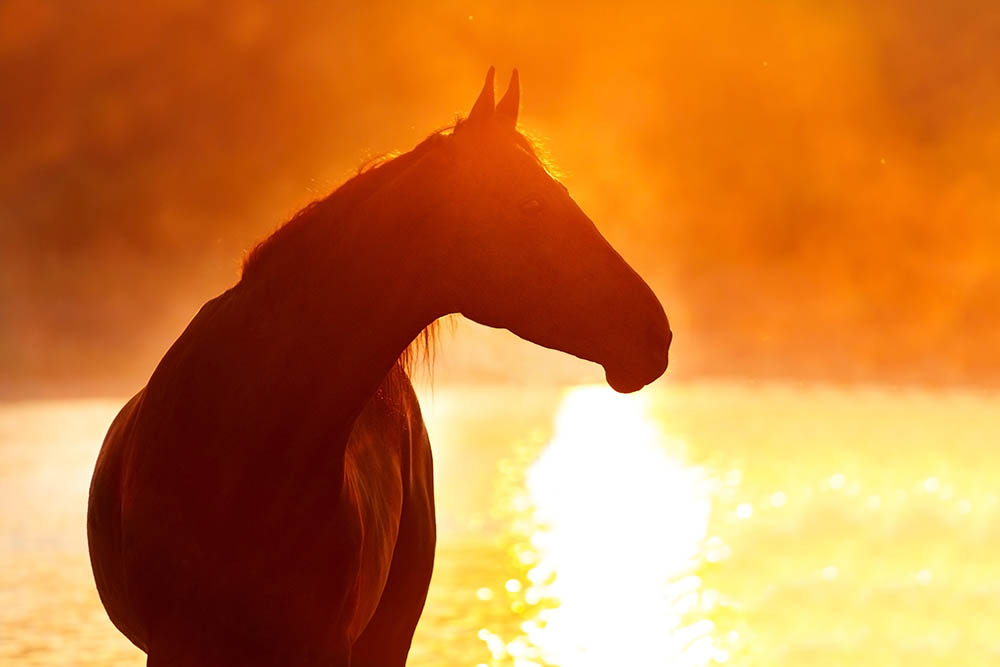Did you know that environmental light is the most important cue influencing a horse’s mental and physical wellbeing? Like humans, horses need light for more than just vision.

Special cells at the back of the eye respond to blue wavelengths of light. As sunlight is naturally high in blue light, this serves to regulate internal rhythms throughout the horse’s body. This system, called the circadian system, controls the activity of nearly every cell in the body, ensuring the body clock stays in tune with the daily light/dark cycles.
Body Clock: An organism’s natural internal timing system, a biological mechanism which causes your body to automatically behave in particular ways at particular times of the day. It functions to keep the body’s activities synchronised with the external environment. The body clock is affected by a number of external factors, primarily light, but also feeding and exercise.
Circadian Rhythm: From the Latin words “circa”, meaning about, and “dies”, meaning day, circadian rhythms are physical, mental and behavioural changes that follow an approximate 24-hour cycle and ensure the body clock stays in tune with the daily light/dark cycles. These rhythms function to coordinate internal physiology and behaviour with the external environment to support health, behaviour and wellbeing. Examples of circadian rhythms include sleep/wake patterns, eating habits, alertness, performance, heart rate, body temperature and blood pressure.
Exposure to the wrong kind of lighting at different times of day plays havoc with an animal’s circadian system, causing it to flatline. The consequences of circadian disruption are well known in humans and include sleep disturbances, low alertness, impaired performance, immune suppression, illness and disease. The key to wellbeing is strong internal rhythms driven by consistent exposure to biologically effective blue light by day.
For stabled performance horses, lighting is particularly important. The equine industry has made amazing advances in nutritional science, veterinary medicine and training technologies, but until recently little attention was given to the level or quality of daily light a horse receives or the role it plays in ensuring optimal health, condition and behaviour.

DURATION OF LIGHT
The first key understanding is the duration of daytime light exposure. Horses are long-day seasonal breeders with the natural reproductively active period coinciding with the light-filled days of summer. To advance seasonal reproductive activity, a switch from a short day to a long day needs to be experienced by breeding stock. A normal winter’s day consists of a long night and a short day, and a long summer day consists of approximately 16 hours of light and 8 hours of dark. The most effective way to bring forward the horse’s breeding season is to shift the horse’s exposure to lighting from a short day to a long day during the mid-winter months.
This rapid transition in lighting will suppress melatonin levels and activate reproduction, growth and milk production hormones. Once these hormones gradually rise over 6-8 weeks of a long daylight cycle, they are responsible for early ovulations, increased fertility, normal pregnancy lengths, optimum foal growth in utero, improved stallion fertility and the shedding of winter coats.
Melatonin is the hormone associated with darkness and its levels rise at night. Long nights during the winter months result in long durations of high melatonin production shutting down the mare’s reproductive system. Suppressing the rise of melatonin via natural or artificial light lengthens the day and triggers the start of the mare’s reproductive cycle in the spring.
Annual day-length changes associated with the seasons also impact performance in the competition horse. Correct management of lighting allows horse owners to bring forward spring and delay autumn, thereby extending the period of peak performance associated with summer vigour. Longer day-lengths are associated with improved muscle development, alertness, immunity and growth. Increases in daily exposure to biologically effective light can also help to shed a winter coat earlier in the year, as well as maintain the coat condition in the autumn months and avoiding clipping for late season events.

STABLE LIGHT QUALITY
We can see the benefits of good quality light in the overall health of animals. Not all light is equal in its ability to impact the horse’s health. The most important light for regulating circadian rhythms and the body clock is blue light. Normal indoor lighting falls significantly short on providing the optimum light spectrum for humans and animals. For the body’s internal body clock to work most effectively, stable lighting should comprise the following key components: blue-enriched light by day, gradual light transitions at dawn and dusk, and dim red light or darkness at night.
Blue–enriched light: Light that contains a high proportion of short wavelength light from the blue end of the spectrum and best replicates natural daylight. This light does not appear blue to our eyes, but may look cooler. Blue-enriched light contains light wavelengths from 460–490 nanometres which optimally stimulate specialised receptors in the retina that are responsible for signalling the time of day to the brain, and from there to the rest of the body. Blue-enriched light optimally suppresses melatonin during daytime in horses.
Blue-enriched light that best mimics natural daylight boosts metabolism, alertness, appetite, mood and reduces the growth of bacteria. This type of light improves respiratory health, muscle mass and accelerates wound healing. A gradual transition at dawn and dusk allows horses to experience stress-free light intensity changes, similar to the natural environment.
The use of dim red light at night eliminates the need for white light at night. This is hugely important as white light pollution at night can severely disrupt an animal’s circadian rhythms and is a significant cause of reduced health. Finally, an optimum stable lighting system should be easy to program in order to reflect and enhance the natural seasonal changes in day length. EQ
You can find out more about Equilume’s product range by clicking here.
YOU MIGHT ALSO LIKE TO READ:
‘Winter Coat Shedding Made Simple’ – Equilume (Equestrian Life, July 2021)
‘The Power of Light’ – Equilume (Equestrian Life, January 2021)

